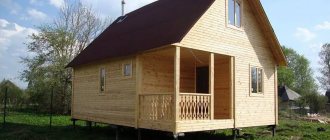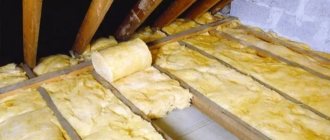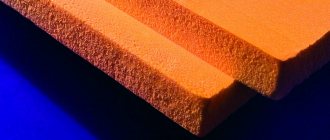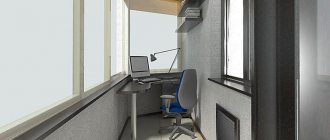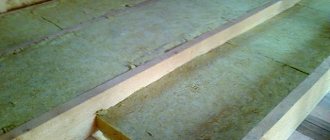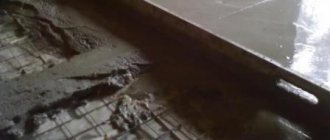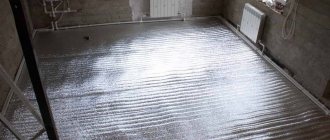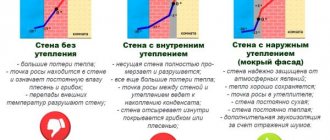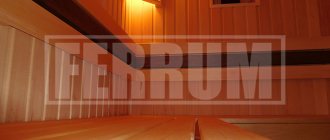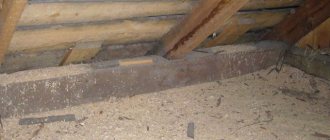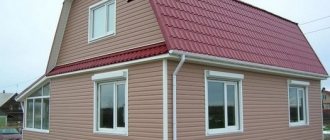Wooden houses are considered thermally efficient, since wood conducts heat poorly. However, in practice, everything turns out the other way around. The material dries out and cracks, causing the cold to penetrate inside faster.
Floors are made mainly using frame technology, so layers of insulation must be laid inside them. The thickness of the floor insulation in a wooden house depends entirely on the selected heat insulator.
Laying mineral wool - not the best quality work
General information
The thickness of the material is selected depending on the climate of the region. One indicator is provided for the northern republics, and another for the southern republics.
Firstly, the thicker the insulation, the better the heat is retained, and the less energy is spent on heating. Secondly, insulation also saves you from heat. Thirdly, insulation is a good sound insulator.
The thickness varies depending on the type of floor and its location. The floor of the first floor is the coldest, especially if the house is on stilts and is ventilated from below. But it can be earthen if the foundation is strip, and concrete if it is slab.
The floors between floors are heated on both sides. Insulation is used only as sound insulation.
The attic floor is also a floor. It must be insulated, especially if the attic is unheated. Otherwise, the heat will go outside, and in addition condensation will appear on the ceiling.
Insulation thickness under a heated floor system
Each material has its own thermal conductivity coefficient. This parameter is of primary importance when determining the thickness of insulation.
Thermal conductivity of insulation of different densities
The effectiveness of insulation also depends on the density. The higher it is, the more difficult it is for the insulator to retain heat.
Comparison of thermal conductivity of materials
12 cm of polystyrene (density, however, not indicated) will retain heat as effectively as 210 cm of solid red brick.
Preparatory work before installation
When laying insulation, it is imperative to use various construction and measuring tools. Regardless of what kind of insulation will be used, the installer must keep a level, tape measure, hacksaw, screwdriver, etc. on hand.
To fasten and close the joints of the waterproofing film, you must use construction tape or polyurethane foam.
If the work is carried out in a house where the floor has already been installed, it is necessary to inspect the load-bearing beams and, if necessary, make minor repairs. You must be prepared for the fact that some of them may have to be replaced.
It wouldn’t hurt to treat them with antiseptic and fire-fighting compounds. By the way, during an inspection, traces of small rodents may be found; accordingly, measures must be taken to prevent their movement in this space.
In addition, it is necessary to remove debris and dust that has accumulated during the use of the floor.
All wooden materials (beams, boards) must be dried. There should be no traces of rotting on their surface
Overview of polymer materials
It is important to study specific insulation materials and compare them with each other.
Polystyrene foam thickness
This material is usually called polystyrene foam, but this is not entirely true, since foam plastics are a huge group of polymer foam materials.
Expanded polystyrene boards are one of the most effective insulation materials
Kinds:
- Pressless, suspension - marked as PSB. The most inexpensive of the others. The price per square meter with a thickness of 20 mm is only 40 rubles. The structure consists of large granules glued together. When broken, it begins to crumble. Such expanded polystyrene is not dense, you can’t make a screed on it, it is flammable and can easily be turned into dust by rodents. It can be used as insulation for the floor of a wooden house, but low quality will not give the desired result.
- Pressed polystyrene foam (PS) has closed cells. During production, some brands of latex PVC and blowing agents are added. It retains heat perfectly, has a stronger and denser structure, and is not afraid of mold. But it is not used primarily for insulating floors, but the next type.
- Extruded polystyrene foam (EPS) - is obtained by squeezing the molten mass through holes of a certain shape. It has a dense structure, all cells are closed, which means the material does not absorb water and tolerates mechanical loads - it can be used for plastering and concrete screeding.
Each type of polystyrene foam has a different density and thermal conductivity, but in general, as insulators, they are all effective.
The material can be purchased in different thicknesses - from 5 to 100 mm. If you need to install 10 cm of material for insulation, take not a slab of comparable thickness, but two layers of 5 cm each, and install them overlapping. This approach eliminates cold bridges formed at the seams.
Expanded polystyrene boards 10 cm thick
Individual slabs have profiled edges for easy joining. Heat loss is also reduced.
Advice! When installing expanded polystyrene boards, it is additionally recommended to coat the seams with polyurethane foam. By the way, this material also belongs to foam plastics.
The thermal conductivity coefficient of pressless polystyrene foam is 0.05 W/mC. The extrusion indicator is lower - 0.04 at a density of 40 kg/m3, despite the higher density.
Underfloor ventilation
In the space under the floor, air exchange occurs due to the natural movement of air masses. This can be done by installing vents - holes located diagonally from each other in the floor through which ventilation will take place. But the required level of air exchange still cannot be achieved with the help of holes alone. Vents will need to be made along the entire perimeter of the base, one or two in each of the walls. If there are solid partitions inside the basement, they will also be equipped with holes. Each of them should be slightly offset relative to the one opposite. The recommended vent diameter is ten centimeters.
It is better to insulate the underground space located under the building. Modern types of heat insulators make it possible to minimize the level of heat loss in a building associated with heat leakage in the basement. In winter, it is better to leave the vents open, and only cover some of them in severe frosts.
Insulation class mineral wool
It is profitable and safe to insulate wooden houses with mineral wool.
Mineral wool is more often used for wooden houses
If we compare mineral wool with expanded polystyrene, with a comparable density, the thermal conductivity coefficient of the former will be on average 50% higher.
Where 5 cm of polystyrene foam is enough, 7.5 cm of mineral wool can replace it. There are several varieties of mineral wool with different characteristics. Products from different manufacturers vary significantly in quality.
Comparison of the characteristics of mineral wool from well-known Russian manufacturers
Types of mineral wool:
- Glass wool is the most affordable, containing harmful formaldehydes. It generates a lot of dust, so it is practically not used for residential premises.
- Slag wool is also a material harmful to health due to phenol-formaldehydes. There are composite models that contain up to 20% wool. Slag wool retains heat more effectively. It can be used for the floor of an unheated attic.
- There are several types of stone wool. They have the same disadvantages as the previous types, but to a lesser extent. Basalt wool does not burn even when heated to +1000 degrees.
Foil-coated basalt wool
Such insulation costs on average from 100 to 160 rubles per square meter with a thickness of 5 cm.
Mineral wools are vapor permeable, which is considered a great advantage and disadvantage. When wet from steam, they lose thermal efficiency; glass wool suffers more than others.
Therefore, they must be protected with vapor barrier films.
This need not be done in interfloor ceilings when all rooms are heated. The steam simply passes through, the moisture evaporates, and the insulation dries out.
Wool with a density of more than 150 kg/m3 is used as a base for screed, although it is better to use extruded polystyrene foam.
To insulate frame floors, you can use wool with the lowest density, which will make insulation more effective.
The frame floor and walls are insulated in four layers
If we average the layer thickness for structures facing the street, the average thickness of mineral wool is taken to be 15 cm.
The floors are also insulated in layers. For mineral wool, a rigid base is required, since low-density material cannot support its own weight without sagging.
Optimal thermal insulators
What material is best to use for finishing the rough coating with your own hands? To insulate wooden floors, both natural and synthetic thermal insulators are used. The most popular of them include:
- Wood sawdust;
- Expanded clay;
- Minvatu;
- Izolon;
- Styrofoam;
- Penofol.
Each material has its own technological features and thermal insulation parameters. To understand their disadvantages and advantages, let’s consider all of the above heat insulators in more detail.
Foiled insulation
There are many manufacturers producing insulation materials. Someone is developing unique technologies that make products more energy efficient. Therefore, relying on average indicators is not always productive.
It is worth noting products supplemented with a layer of aluminum foil on one side. Aluminum reflects heat. Its thin layer allows you to increase the efficiency of the entire “pie” and reduce its thickness.
The foil layer is always located on top.
Foil penoizol
Some polymer insulators and mineral wools also have this addition.
Foiled mineral wool
The use of a foil layer is especially effective when installing heated floors. The reflection of energy will not allow the street or ground to warm up.
Also, structural materials can be supplemented with substrates and slabs made of rigid materials to simplify installation.
Thanks to the textile backing, it was possible to secure low-density mineral wool under the ceiling
Substrates increase the resistance of materials to loads. It is profitable to buy them if the insulation is from below, from the basement or lower floor.
Dense insulation materials, such as extruded polystyrene foam, can serve as a foundation in a wooden house (example in the photo).
The subfloor is assembled from insulation
The combination of mineral wool and expanded polystyrene reduces the overall thickness of the ceiling, making it maximally protected.
How to insulate
What materials are best suited for floor insulation in a wooden house.
Sand or expanded clay
The simplest natural materials that can be used for floor insulation. In addition, they are also the most inexpensive. These insulation materials are simply poured onto the rough flooring, thereby creating a dense layer between this flooring and the regular floor.
These materials are of natural origin, which means they are safe from an environmental point of view. In addition, they have a dry structure and absorb moisture well - this will help protect the floor from fungus and mold.
The downside is that these materials lose their ability to absorb moisture over time, so we can’t talk about the durability of these insulation materials.
What is the density of insulation for a ventilated facade and how to make the calculations correctly is described in this article.
But what is the best insulation for roofing exists and how to make the right choice, information from the article will help you understand.
It will also be interesting to know what the technical characteristics and price of Izover insulation are: https://resforbuild.ru/paneli/utepliteli/izover-texnicheskie-xarakteristiki.html
Maybe
Other materials for insulation
Internet users often ask what the expanded clay layer should be for floor insulation. This indicates a lack of understanding of the purpose of some materials.
The use of expanded clay for insulation
Expanded clay
Over time, this bulk material will shrink and its thickness will decrease.
The thermal conductivity coefficient at a minimum density of 200 kg/m3 is 0.1 W/mC, which according to GOST is sufficient for insulating the external structures of a single-family residential building.
But this is 30% worse than mineral wool.
Expanded clay significantly loads frame floors. It can only be used in a wooden house on floors built on the ground, as a base for a screed.
Ecowool
Another material that belongs to the controversial category is ecowool.
Laying ecowool on a wooden floor
This material is free-flowing and is made by recycling waste paper.
The thermal efficiency coefficient is only slightly inferior to penoizol, but only when using wet spraying.
It does not burn, does not rot, does not attract rodents and is inexpensive. The average price per kilogram is 60 rubles.
If you simply pour ecowool on it, it will not retain heat as effectively. If it is sprayed, the moisture contained in the material will evaporate within 1-2 months, which will lead to rotting of wooden structures.
Our country has not yet developed a unified standard for this material. As a result, manufacturers sell whatever they want. There is no need to talk about any security. And the final cost is high.
For high-quality insulation of a wooden house, you can use natural insulation materials, which are made from flax, coconut, wool, and various trees. They are very effective, environmentally friendly, but expensive.
We recommend reading: insulating the floor of a frame house on stilts.
Conclusions and useful video on the topic
You can visually familiarize yourself with the process of floor insulation using joists from this video:
It can be seen that the process of floor insulation using joists is not as costly and labor-intensive as it seems at first glance. The choice of insulation is always at the discretion of the owner. In addition to sawdust and expanded clay, any of the listed materials will be optimal. With the exception, perhaps, of polystyrene foam, the cutting of which will require a lot of tinkering.
Do you have a different opinion about floor insulation? Please share it with people who are encountering this issue for the first time. Leave your comments in the communication block located below the article.
Calculation of floor insulation thickness
The norms for climatic conditions are as follows.
Standardized resistance by country's republics
3 values are indicated for each region. The second is for floors.
The temperature resistance of the material is calculated as follows: R=h/λ, where h is the thickness of the material, and λ is the temperature coefficient. Accordingly, by rearranging the values, you can derive the thickness formula: h=R*λ.
But the floor does not consist only of insulation. To reach this value, it is necessary to calculate the heat loss resistance of all installed materials, subtract it from the standardized value, and leave the rest for the insulation.
The floor of a wooden house in several layers
The simplest example. The bottom of the floor is lined with 25 mm thick boards. Top – 30 mm. Total 55 mm layer of wood. Specify the type of wood, find its heat loss coefficient, and calculate the value of Rder. Then 3.13-Rder, and you get R for insulation.
We recommend reading: insulating a frame house from the outside.
Features of thermal insulation of the first floor
Since wood tends to deform, over time, cracks may form in the floor, through which heat gradually begins to escape from the room. How to make high-quality insulation of the first floor in an old house?
- The first step is to remove the old flooring;
- Then the lag is inspected for deformation or rotting;
- If necessary, rotten beams are replaced;
- Then they treat the wood with an antiseptic with their own hands;
- From below, blocks for laying wooden boards are nailed to the joists;
- Insulation is poured onto the boards;
- Next, lay a layer of vapor barrier;
- The work is completed by installing the finishing coating.
The insulation technology is shown in detail in the video.
Obviously, a layered cake of additional heat and vapor barrier layers provides the floor with reliable protection from basement drafts and condensation.
